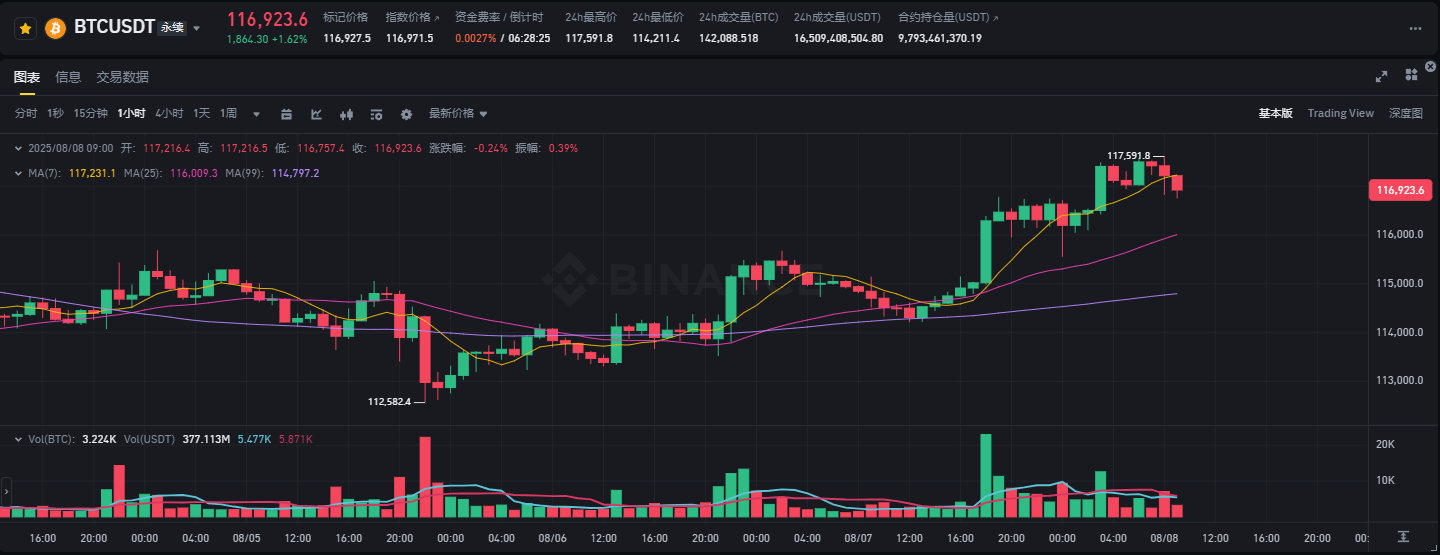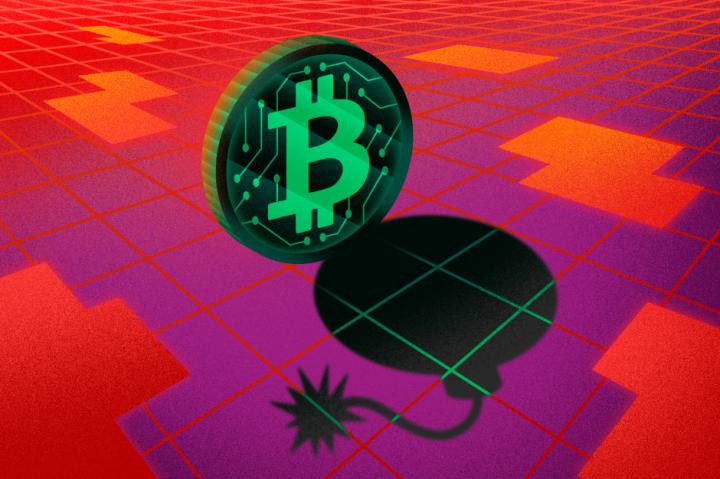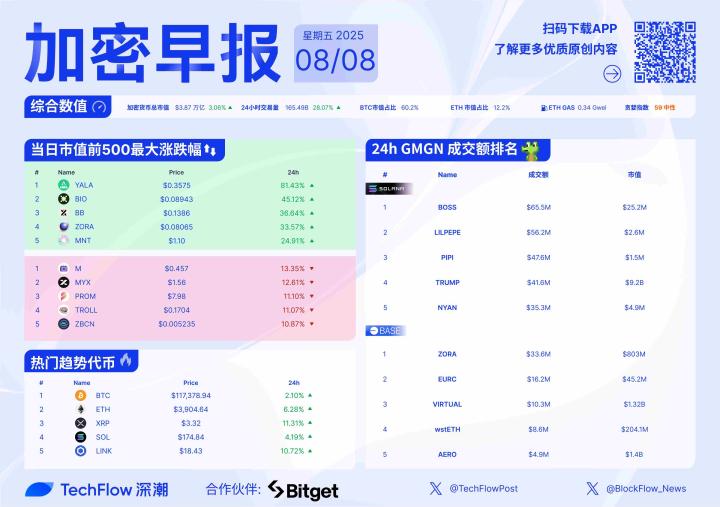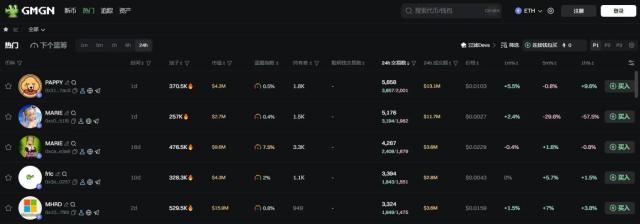A capital game surrounding retirement savings of ordinary Americans has quietly unfolded, with Bitcoin breaking through $117,000.

At noon Eastern Time on August 7th, in the Oval Office, an executive order signed by Trump officially removed the investment barriers of the US 401(k) retirement plan that had lasted for half a century. This order was like a lightning bolt cutting through the crypto world's night sky, instantly igniting market enthusiasm: Bitcoin surged $2,000 within 15 minutes, breaking through the $116,000 mark, Ethereum soared 5% to over $3,800, and Altcoins like Solana and Dogecoin collectively went on a rampage.
The core of the executive order is to mandate the Department of Labor to re-evaluate investment guidelines under the 1974 Employee Retirement Income Security Act, opening the door to a $12.5 trillion market for alternative assets such as cryptocurrencies, private equity, and real estate.
More noteworthy is the establishment of an inter-departmental collaboration mechanism. Trump instructed the Labor Secretary to work with the Treasury Department, SEC, and other institutions to assess whether rule modifications are needed to promote this work, and specifically requested the SEC to provide convenient channels for participants to access alternative assets in self-managed retirement plans. This multi-agency collaborative instruction is clearly aimed at breaking through existing regulatory barriers and clearing obstacles for alternative assets to enter the retirement market on a large scale.
Historic Breakthrough: The "Safe Asset" Boundary of 401(k) Collapses
As the most mainstream employer-sponsored retirement savings tool in the US, the 401(k) plan has built a solid "safe asset" boundary since its inception. For nearly half a century, retirement funds for millions of American workers have been strictly limited to publicly traded market products like stocks, bonds, and mutual funds. This conservative allocation logic stems from the fundamental nature of retirement funds - prioritizing value preservation and risk aversion.
Trump's executive order directly challenges this traditional logic that has been running for decades. According to the latest data from the Investment Company Institute (ICI), as of the first quarter of 2025, Americans collectively hold approximately $8.7 trillion in 401(k) accounts, accounting for 71% of all fixed contribution plan assets. The entire employer-sponsored retirement plan scale reaches $12.5 trillion, equivalent to 3.5 Apple market capitalizations or 7 Bitcoin total market values.
Signals of policy relaxation had long been foreshadowed. In April, Fidelity Investments, with asset management scale of $5.9 trillion, was the first to launch a retirement account allowing cryptocurrency allocation; retirement funds in states like Arizona and Wisconsin have quietly invested hundreds of millions of dollars in the crypto market.
In June, the world's largest asset management firm BlackRock announced the launch of a target-date 401(k) fund in the first half of 2026, with 5%-20% of assets allocated to private markets.
Market estimates of potential capital inflows are shocking: Dragonfly partner analysis indicates that just 1% allocation of crypto in 401(k) assets could bring about $90 billion in new funds, equivalent to nearly 5% of the current crypto market capitalization. Calculated based on the total 401(k) scale of $12.5 trillion, a 1% allocation would reach $125 billion.
Political Economy: Trump's Crypto Ambitions and Capital Alliance
On the surface, it appears to be an expansion of retirement fund investment scope, but it is actually a precisely designed political and economic layout. Trump's policy shift is not an isolated action but a key component of his crypto strategy combination.
In March 2025, Trump signed an executive order establishing a "Strategic Bitcoin Reserve", incorporating approximately 200,000 Bitcoins held by the US government into national reserves, although the strategy shifted from a planned "orderly purchase" to "store but not buy".
In July, the US House of Representatives passed the "Genius Act" with 308 votes to 122, establishing a federal regulatory framework for stablecoins, requiring issuers to hold 1:1 US dollar asset reserves. On the same day, the "Clear Act" passed the House, clearly dividing digital assets into securities and commodities, resolving the regulatory ownership dispute that has plagued the industry for years.
More critical personnel arrangements have emerged: Trump appointed David Sacks, former PayPal COO, as the first "White House AI and Cryptocurrency Czar". Sacks publicly stated: "US dollar stablecoins can ensure US dollar international dominance and create trillions of dollars in US debt demand." This reveals the deeper strategic intent behind the policy - strengthening US dollar hegemony through cryptocurrencies.
The interest chain is equally intriguing. According to the Bloomberg Billionaire Index, several crypto projects launched by the Trump family have increased their net assets by at least $620 million in recent months. Projects led by his children, such as World Liberty Financial (WLFI), American Bitcoin, and the utility token planned for Trump's Truth Social platform, all have subtle temporal correlations with the policy shift.
In terms of political donations, private equity and hedge funds, as traditional Republican donors, are pleased with this policy. Giants like Blackstone and BlackRock have long anchored their long-term growth strategies on capturing retirement savings capital inflows. After policy relaxation, the $12.5 trillion retirement fund will become fertile ground for their management fee growth.
Risk Controversy: Retirement Funds Becoming "Policy Experiment Guinea Pigs"?
Accompanying the market celebration are sharp waves of questioning. Professor Jeffrey Hooke from Johns Hopkins Carey Business School issued a warning: "Private assets not only have poor liquidity and high fees, but their long-term returns also have high uncertainty about outperforming the stock market." Moody's analysts are concerned that if funds rush into such low-liquidity assets in the short term, it might plant the seeds of systemic risk.
Risk dimensions are specifically manifested in three aspects:
Volatility Trap:Bitcoin's annual fluctuation exceeds 60%, which fundamentally conflicts with retirement funds' value preservation needs. Critics directly state that exposing ordinary people's retirement money to markets with non-transparent valuation, extreme price volatility, and imperfect regulation might turn millions of depositors into "policy experiment guinea pigs".
Liquidity Black Hole:Private equity investments often concentrate on a few invested companies, with liquidity far lower than stocks and bonds. Brian Paine, chief strategist at BCA Research, points out that if economic recession leads to rising unemployment and forces more people to prematurely use 401(k) accounts, a liquidity crisis might erupt.
Fee Erosion Effect:Private funds generally charge a 2% management fee + 20% profit sharing rate, compared to index funds' 0.03% management fee, which will significantly erode long-term returns. Assuming an initial investment of $100,000, a 2% annual fee rate will reduce final returns by nearly 50% after 30 years.
Legal risks also loom. Retirement plan managers recommending high-volatility assets might face class-action lawsuits. Although the executive order requires the Department of Labor to clarify the fiduciary position, in actual operations, when depositors lose money investing in alternative assets, responsibility definition remains in a blurry area.
Even more worrying is the financial literacy gap. Most wage earners lack professional investment knowledge and might passively accept financial institutions' "innovative products". Meanwhile, institutions, driven by interests, might conceal real risks through complex product designs. This information asymmetry will place ordinary depositors at a disadvantage.
Implementation Challenge: The Regulatory Maze and Conflict of Interest Dilemma
Policy implementation still faces numerous obstacles. Despite Trump's executive order requiring multi-department collaboration to clear barriers, the inherent contradictions in the regulatory system are difficult to resolve easily.
The "Genius Act" Exposes Three Regulatory Loopholes:
Tiered Regulatory Arbitrage: The act's exemption for small-scale issuers (<$100 billion) opens the door wide for regulatory arbitrage. Issuers can choose to register in states with lax regulations, avoiding federal review, leading to a proliferation of high-risk stablecoins.
Reserve Fund Management Risks: Allowing non-liquid assets like commercial paper and repurchase agreements as reserves recreates the 2008 shadow banking crisis risk—synthetic dollar claims far exceed actual liquidity.
Lack of Emergency Mechanisms: Unlike banks, stablecoin issuers cannot obtain liquidity support from the Federal Reserve, making bank runs inevitable. USDC's dramatic fluctuation during the Silicon Valley Bank incident is a cautionary tale.
Conflict of interest issues are equally thorny. The launch of Trump Coin (issued by World Liberty Financial) intertwines the president's personal interests with public policy. The risk of regulatory capture intensifies—Trump's appointment of crypto-friendly Paul Atkins as SEC chairman may lead to weakened enforcement, prioritizing industry profits over systemic stability.
Coordination at the state level is even more complex. Some states have excluded digital asset transactions from money transfer laws, while others have established specialized digital asset regulatory systems. This patchwork regulatory landscape makes it difficult to establish nationwide retirement fund investment standards.
The Department of Labor faces significant practical challenges. The six-month timeline to reassess investment guidelines is quite tight, with key issues to resolve including:
- Whether to set allocation caps for assets of different risk levels
- How to establish fair valuation mechanisms for alternative assets
- How to define the boundaries of fiduciary responsibility for plan managers
A New Capital Order: Wall Street's Institutional Flood
As Washington's policy gates open, Wall Street's capital machine has long been roaring to life. Traditional asset management giants like BlackRock and Fidelity have keenly sensed opportunities, competing to launch alternative asset products for retirement accounts. Empower, the second-largest retirement plan service provider in the US, announced collaboration with asset management companies like Apollo to introduce private asset allocation in some accounts later this year.
Market structure transformation is evident in three dimensions:
Accelerated Product Innovation:BlackRock's 2026 target date fund design, reserving 5%-20% private allocation, signals that hybrid retirement products will become mainstream. Such products will package complex alternative assets into simple options, lowering the entry barrier for ordinary savers.
Trading Channel Integration:JPMorgan Chase and Coinbase's collaboration sets a precedent—credit card points can be instantly converted to USDC on the Base chain. The century-old wall between traditional banks and crypto exchanges is crumbling, paving a technical channel for retirement funds to enter the market.
Service Ecosystem Reconstruction: The service chain composed of independent investment advisors, third-party actuarial institutions, and custodian banks is being reshuffled. Demand for due diligence services focused on alternative assets has surged, giving birth to new professional service tracks.
The long-term capital landscape is being reshaped. Private equity assets have more than doubled in the decade ending 2023, while the number of US-listed companies has decreased by 40% from its 1990s peak. The shift in retirement fund flows will accelerate this trend, providing stable long-term capital to the private market while potentially causing public market liquidity to gradually shrink.
For the crypto industry, this marks the end of its wild growth era. As national retirement funds and other conservative capital enter, the market will be forced to enhance transparency, improve custody solutions, and strengthen compliance. Bitcoin's transformation from a "speculative symbol" to a new savings option in US retirement accounts may see its market volatility gradually converge as institutional share increases.
As Bitcoin surged to $117,000 after the executive order, short sellers were liquidated $261 million within 24 hours, with 90,000 investors losing everything overnight. The brutal side of this capital feast reminds us: when the national machinery injects nuclear-level liquidity into the crypto world, volatility and risks will also be upgraded to a strategic level.
The Trump family's crypto asset wealth increase of $620 million stands in stark contrast to the risk exposure of ordinary teachers' and truck drivers' retirement savings. Whether the regulatory system can balance deregulation and investor protection will determine the ultimate outcome of this experiment—whether it opens a new era of inclusive finance or brews another "retirement fund crisis". With Wall Street's knives and sickles simultaneously at work, the fate of ordinary Americans' lifelong savings is now closely tied to the wild pulse of the crypto market.








